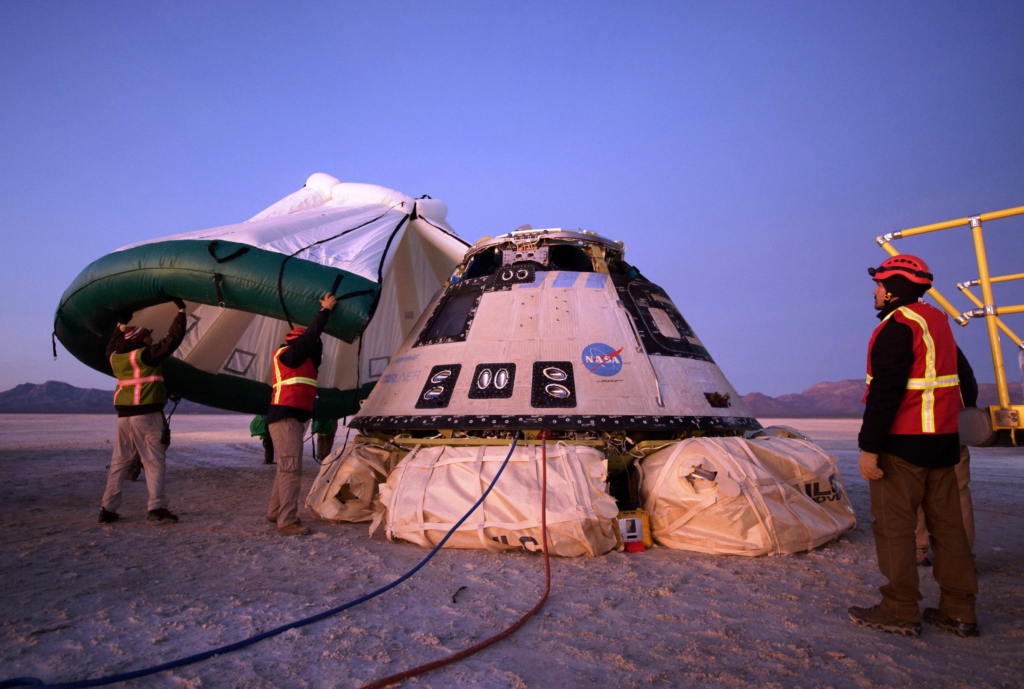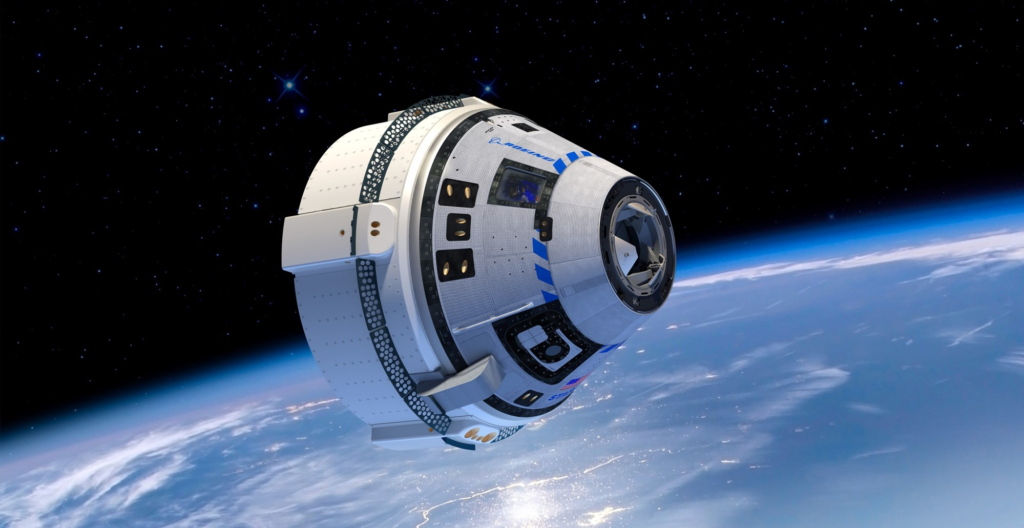
Starliner’s First Crewed Flight Test Could Be Weeks Away
For a while now Boeing and NASA have been working to check off a long list of to-dos related to the Boeing Starliner. After the last uncrewed test flight, this list was quite large and included major safety features and alterations to the spacecraft. By now in late May, the agency is still aiming for the first crewed launch to take place just over seven weeks from now in July.
However, based on new reports from the Agency and Boeing, it looks like quite a bit of work is still necessary before they are ready for Starliner to lift off. This could push the launch back even more depending on exactly how much work needs to be completed. Not long ago the launch was delayed from April to July.
Something NASA needs to get right as human and astronaut safety is the number one priority on this mission. Here I will go more in-depth into the recent update from Boeing, what still needs to be completed prior to lift-off, what to expect in the coming months, and more.
A Long Checklist

Days ago on the 25th, NASA and Boeing completed a joint Crew Flight Test checkpoint review ahead of the first flight of Starliner with astronauts to the International Space Station. During the checkpoint, mission teams reviewed open work ahead of launch planned no earlier than July 21, including different issues that need a path to closure prior to a decision to fuel the spacecraft in June.
In relation to this, Steve Stich, NASA’s Commercial Crew Program manager commented, “We are taking a methodical approach to the first crewed flight of Starliner incorporating all of the lessons learned from the various in-depth testing campaigns, including Starliner’s flight tests and the agency’s verification efforts. All Orbital Flight Test-2 anomalies are closed. In addition to the closeout of ongoing work, the team remains vigilant on tracking new technical issues as we complete certification for crewed flight” he said.
The agency pointed out that as part of the ongoing effort, 95% of the Crew Flight Test certification products are complete. This includes approval of Starliner’s crew module batteries, based on additional testing and analysis, along with post-certification flight mitigations and a proposed battery upgrade for future missions. Teams are conducting final spacecraft closeouts and preparing for upcoming hardware milestones, including spacecraft fueling, spacecraft rollout to the launch site, and integration with the United Launch Alliance Atlas V rocket.
All this being said, there is a decent list of things that still need to be completed. For one, teams will remove and replace a by-pass valve on the active thermal control system, which is located on the Starliner service module and is used to flow coolant into the system to cool the onboard avionics. The Starliner team is replacing the valve that was restricting flow to one of two redundant loops, and running a diagnostic to confirm the suspected issue with the malfunctioning hardware. This work is expected to take about a week with no overall impact to the launch schedule at this time.
Engineers also are working to evaluate any elevated risk from a specific type of tape used on the spacecraft to protect wires from chaffing. Although the tape is commonly used in spaceflight, the adhesive properties of the tape could present a flammability risk under certain conditions. NASA and Boeing are evaluating this material and the system’s overall wiring protection to confirm it is acceptable for crewed flight. Those efforts are ongoing and are expected to complete before Boeing begins fueling operations on the spacecraft.
Lastly, NASA and Boeing also are working to reassess Starliner’s parachute system margins based on new data reviews as part of the ongoing design certification process. Engineers are reviewing the overall efficiency of certain joints within the parachute system to confirm they meet all required factors of safety for crewed flight. Months ago we saw some extra testing related to the parachute system and internal features.
“Crew safety remains the highest priority for NASA and its industry providers, and emerging issues are not uncommon in human spaceflight, especially during development,” said Stich. “If you look back two months ago at the work we had ahead of us, it’s almost all complete. The combined team is resilient and resolute in their goal of flying crew on Starliner as soon as it is safe to do so. If a schedule adjustment needs to be made in the future, then we will certainly do that as we have done before. We will only fly when we are ready” he said.
Realistic Launch Date

In NASA’s recent report, they finished by saying, “Starliner spacecraft fueling is expected to begin as early as mid-June, and there is some operational flexibility in that timeline that can be used if needed. Teams will continue to monitor the forward work and determine whether an adjustment in the current launch date is needed. An update on the team’s progress will be provided in the coming weeks.”
This statement is slightly concerning as it suggests that they are expecting to need at least a bit more time before they can fuel and prep Starliner for launch. If this is the case and they delay the mission, the next opportunity would be a few months away giving the agency and Boeing plenty of time. Days ago when asked when he thought the launch would happen Eric Berger responded “Fall”. This would be about a two to three-month delay from the current date which seems realistic. However, all this being said, it’s possible that NASA and Boeing complete these final checkouts quickly and everything looks good for a launch in the middle of July.
As partially mentioned prior, a few months ago when the launch was delayed from April to July, there were concerns and questions brought up regarding the parachute system. Specifically, Steve Stich, said most of the work needed to prepare the CFT mission for launch to the International Space Station would be done by April. An exception, he said, is certification work on the capsule’s parachutes. “There’s no issues or concerns with the parachute system,” he said. “It’s just a matter of going through all that data and looking at the data and making sure we’re ready to go fly safely.”
The parachutes are installed on the spacecraft, but Stich said that one more ground test is planned of an element of the parachute system, a parachute that removes the cover on the top of the spacecraft to expose the rest of the parachute deployment system. That test is designed to confirm that it can operate as planned in what he described as the “highest possible regime” during an abort. On the other hand, Mark Nappi, vice president and program manager for Starliner at Boeing, said the delay in that parachute certification work was the fault of both the company and NASA. “It took longer for us to get the product over to NASA, and it’s taken a little bit longer for NASA to review it with us,” he said. As of today, it looks like they still want to do a bit of work on this system prior to launch.
Carrying crew for the first time is a very big deal and it becomes even more important to prep the spacecraft when some of its past launches experienced a host of issues. Software problems and other issues occurred during the first test flight, preventing the spacecraft from reaching the International Space Station. During the OFT-2 launch window, issues were detected with 13 propulsion-system valves in the spacecraft prior to launch. Attempts to fix the problem at the VIF also failed, and Boeing decided to return the spacecraft to the factory, thus canceling the launch at that launch window. They eventually found out that the valves had been corroded by the intrusion of moisture, which interacted with the propellant, but the source of the moisture was not apparent.
Eventually, the OFT-2 mission launched on May 19, 2022. During the flight, two Orbital Maneuvering and Attitude Control System (OMACS) thrusters failed during the orbital insertion burn, but the spacecraft was able to compensate using the remaining OMACS thrusters with the addition of the Reaction Control System (RCS) thrusters. A couple of RCS thrusters used to maneuver Starliner also failed during docking due to low chamber pressure. Not only this, but some thermal systems used to cool the spacecraft showed extra cold temperatures, requiring engineers to manage it during the docking. Despite these issues, on May 22, the capsule docked with the International Space Station. Days later on May 25, the capsule returned from space and landed successfully.
The mission was successful but it also made it clear that even after a bunch of changes made to the spacecraft after the first launch, more work was needed. The spacecraft had docked to the ISS and landed but there were still a few too many complications along the way to comfortably launch humans. Since this launch, they have been working constantly to try and avoid any issues. The coming weeks will determine whether or not a launch in July is possible or if it will be pushed back.
Conclusion
NASA and Boeing are not far away from the first crewed test flight of Starliner with two astronauts. This mission will see the spacecraft launch on an Atlas V and dock to the ISS before returning home not long after. We will have to wait and see how it progresses and the impact it has on the space industry.
